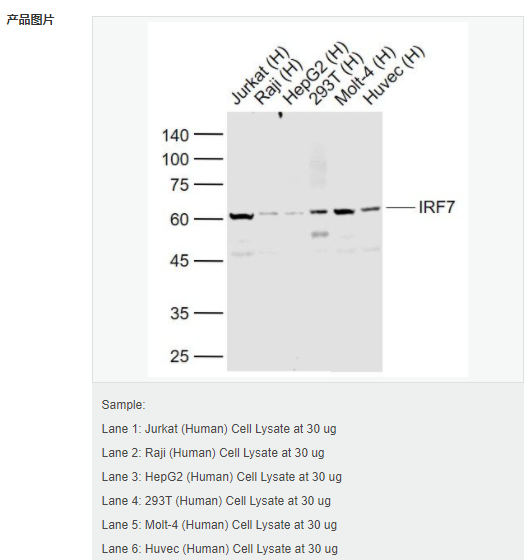
货号
产品规格
售价
备注
BN42086R-50ul
50ul
¥2020.00
交叉反应:Human 推荐应用:WB
BN42086R-100ul
100ul
¥3240.00
交叉反应:Human 推荐应用:WB
| 英文名称 | IRF7 |
| 中文名称 | 干扰素调节因子7重组兔单克隆抗体 |
| 别 名 | IRF 7; IRF-7; Interferon regulatory factor 7; Interferon regulatory factor 7H; IRF 7; IRF 7A; IRF 7H; IRF7A; IRF7; IRF7H; IRF7_HUMAN. |
| 研究领域 | 肿瘤 免疫学 细胞凋亡 转录调节因子 |
| 抗体来源 | Rabbit |
| 克隆类型 | Monoclonal |
| 克 隆 号 | 2A1 |
| 交叉反应 | Human, |
| 产品应用 | WB=1:500-2000 not yet tested in other applications. optimal dilutions/concentrations should be determined by the end user. |
| 分 子 量 | 54kDa |
| 细胞定位 | 细胞核 细胞浆 |
| 性 状 | Liquid |
| 浓 度 | 1mg/ml |
| 免 疫 原 | Recombinant human IRF7 protein (200-300aa): |
| 亚 型 | IgG |
| 纯化方法 | affinity purified by Protein A |
| 储 存 液 | 0.01M TBS(pH7.4) with 1% BSA, 0.03% Proclin300 and 50% Glycerol. |
| 保存条件 | Shipped at 4℃. Store at -20 °C for one year. Avoid repeated freeze/thaw cycles. |
| PubMed | PubMed |
| 产品介绍 | IRF7 encodes interferon regulatory factor 7, a member of the interferon regulatory transcription factor (IRF) family. IRF7 has been shown to play a role in the transcriptional activation of virus-inducible cellular genes, including interferon beta chain genes. Inducible expression of IRF7 is largely restricted to lymphoid tissue. Multiple IRF7 transcript variants have been identified, although the functional consequences of these have not yet been established. [provided by RefSeq, Jul 2008] Function: Key transcriptional regulator of type I interferon (IFN)-dependent immune responses and plays a critical role in the innate immune response against DNA and RNA viruses. Regulates the transcription of type I IFN genes (IFN-alpha and IFN-beta) and IFN-stimulated genes (ISG) by binding to an interferon-stimulated response element (ISRE) in their promoters. Can efficiently activate both the IFN-beta (IFNB) and the IFN-alpha (IFNA) genes and mediate their induction via both the virus-activated, MyD88-independent pathway and the TLR-activated, MyD88-dependent pathway. Required during both the early and late phases of the IFN gene induction but is more critical for the late than for the early phase. Exists in an inactive form in the cytoplasm of uninfected cells and following viral infection, double-stranded RNA (dsRNA), or toll-like receptor (TLR) signaling, becomes phosphorylated by IKBKE and TBK1 kinases. This induces a conformational change, leading to its dimerization and nuclear localization where along with other coactivators it can activate transcription of the type I IFN and ISG genes. Can also play a role in regulating adaptive immune responses by inducing PSMB9/LMP2 expression, either directly or through induction of IRF1. Binds to the Q promoter (Qp) of EBV nuclear antigen 1 a (EBNA1) and may play a role in the regulation of EBV latency. Can activate distinct gene expression programs in macrophages and regulate the anti-tumor properties of primary macrophages. Subunit: Monomer. Homodimer; phosphorylation-induced. Heterodimer with IRF3. Interacts with TICAM1 and TICAM2. Interacts with rotavirus A NSP1; this interaction leads to the proteasome-dependent degradation of IRF7. Interacts with Epstein-Barr virus LF2. Interacts with MYD88 AND TRAF6. Subcellular Location: Nucleus. Cytoplasm. Note=The phosphorylated and active form accumulates selectively in the nucleus. Tissue Specificity: Expressed predominantly in spleen, thymus and peripheral blood leukocytes. Post-translational modifications: Acetylation inhibits its DNA-binding ability and activity. In response to a viral infection, phosphorylated on Ser-477 and Ser-479 by TBK1 and IKBKE1. Phosphorylation, and subsequent activation is inhibited by vaccinia virus protein E3. In TLR7- and TLR9-mediated signaling pathway, phosphorylated by IRAK1. TRAF6-mediated ubiquitination is required for IRF7 activation (By similarity). Sumoylated by TRIM28, which inhibits its transactivation activity. Similarity: Belongs to the IRF family. Contains 1 IRF tryptophan pentad repeat DNA-binding domain. SWISS: Q92985 Gene ID: 3665 Database links: Entrez Gene: 3665 Human Entrez Gene: 54123 Mouse Omim: 605047 Human SwissProt: Q92985 Human SwissProt: P70434 Mouse Unigene: 166120 Human Unigene: 3233 Mouse Unigene: 101159 Rat Important Note: This product as supplied is intended for research use only, not for use in human, therapeutic or diagnostic applications. |
